15 September 2014. Cayuga ON. Last year, around this time, while doing the daily census at the bird observatory, I took long-distance photos of a couple of mystery birds. They were both high up and hard to get really good looks at. Still my photos were passable so I posted them on a local birding site and asked for others’ opinions. The consensus was that they were both of Scarlet Tanagers, either males in non-breeding plumage, or females, or juveniles. You see, while identifying and appreciating a male Scarlet Tanager in May or June is easy, the same cannot be said for late summer and fall when all of that glorious red-hot scarlet has given way to a drab olive green; now the males look like the females and juveniles. Here’s a couple of shots to illustrate.
Today, I spent the morning at the bird observatory and, as usual, undertook the daily census walk. It’s a hike of a kilometer or so around a prescribed route of various habitats, the task is to record all birds seen and heard. The hike is almost always rewarding and often surprising; only once or twice in the many years I’ve been doing the census have I not enjoyed it and those were only days when it was really miserably cold. The census today turned up a good variety of species including a couple of Black-throated Green Warblers and a Chestnut-sided Warbler, I heard Warbling and Yellow-throated Vireos and saw a couple of Red-eyed Vireos too, all of these birds are heading south, well south, for the winter. I caught sight of a Scarlet Tanager and knew it for what it was, it may be a drab greenish colour, but it’s profile is unmistakable.
In the high tops of some Black Walnut trees I found an Eastern Wood Peewee which was fly-catching and feeding a juvenile. This food dependency by the youngster struck me as very late, but according to the Ontario Breeding Bird Atlas, 2001-2005, egg laying continues into mid August so, allowing three to four weeks for incubation and fledging, it’s perfectly plausible; there’s always something new to learn.
Anyway, back to Bird of the Day. Also high in the tree tops was a yellowish-green bird actively preening itself. It hurt my neck trying to hold still and watch it, my inclination was that I was watching a Yellow-throated Vireo, a choice that was reinforced by the call of another one off to my left. I used my camera to get several shots of it and thought that I could comfortably double-check my identification a little later, somewhere less awkward and involving less neck pain. Identification from below can be a challenge. Well, the upshot of all of this is that, on reviewing the pictures, it became clear that it was not a Yellow-throated Vireo at all (and photographing thank goodness) but rather another Scarlet Tanager, probably a female. The rather stout beak, a slight fork in the tail and the extent of yellow underneath from throat to tail were indicative. The yellow on the underside of a Yellow-throated Vireo is limited to its breast, and then it’s white from belly to tail. As I said above, there’s always something new to learn and for the instructive moment the tanager was my Bird of the Day.
Above is a series of those photos of it preening. It was some fifty feet above me and hardly ever still, I had hoped to capture at least one good full headshot but it turned away every time just as I pressed the shutter.
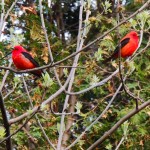
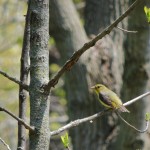
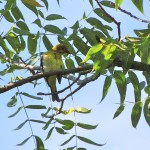
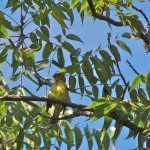
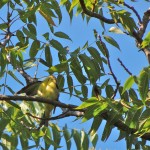
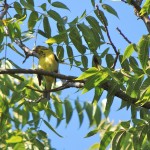
Gotta tell the birds to “watch the birdie”!
IDing birds has got to be one of the trickier things in life! It’s amazing how much their plumage changes (and fools)!